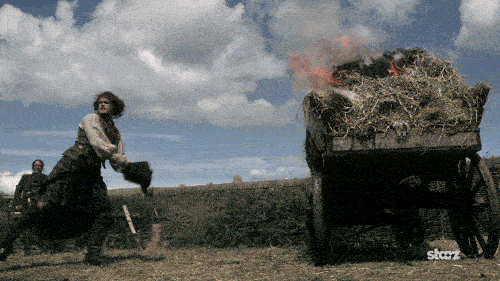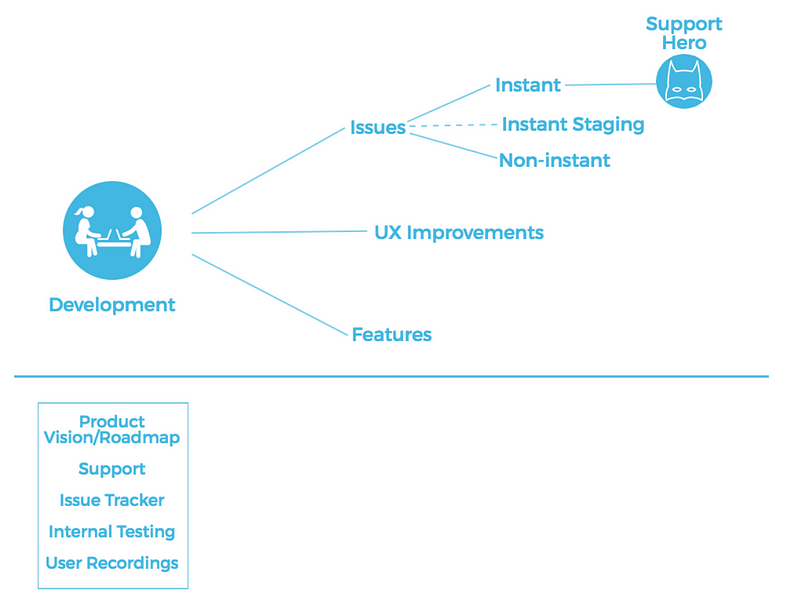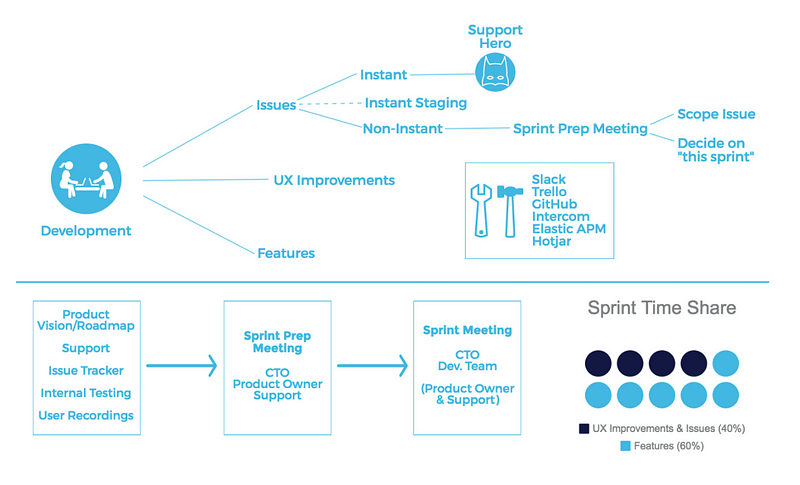Hoe je ontwikkeling organiseert in een lean software startup
Binnen Salesflare
Het opstarten van een technologiebedrijf kan een chaotisch, stressvol en lonend proces zijn.
But one of the things that can really help early on is to have structures in place that empower your team to work effectively and efficiently — especially on the development side. The last thing your company needs is chaos around building your product. 😱
Dus, hoe begin je? En moet je uitbesteden of intern inhuren?
Below is a quick guide to building and structuring your SaaS development team — and if you do decide to outsource, you can use this guide as a framework as well. 🤩
Categorizing development at your company
One of the things that can help with development structure is to break down the different types of development tasks at the company into categories, so you can have a better idea of prioritization, delegation and organization within the team. 🤝
Hieronder staan de drie ontwikkelingscategorieën die we bij Salesflare hebben:
Problemen zijn dingen die kapot zijn en moeten worden opgelost in het product.
But what has priority? And how do you organize them? That’s why we’ve broken issues down into three additional categories: instant issues, instant staging and non-instant issues.
Instant issues are the ones that — you guessed it — need to be addressed immediately. These can be things that are really broken, things that the users notice, things in the app that need to be fixed, etc. 🚨

Instant staging is not as “instant” as instant issues, but these are things that need to be fixed before releasing the newest software version into the production environment. These are mostly issues that we notice on our staging environment through internal testing.
Niet-instant problemen hebben een lagere prioriteit en worden besproken in de sprintvoorbereidingsvergadering (waarover later meer).
UX-verbeteringen krijgen een hogere prioriteit dan niet-instant problemen en omvatten alles in ontwikkeling dat betrekking heeft op de ervaring en bruikbaarheid van het product. In wezen zijn dit dingen die de ervaring voor klanten verbeteren.
Kenmerken zijn nieuwe functionaliteiten die we aan het product willen toevoegen, zoals bulkacties, geavanceerd filteren, enz. Deze hebben de laagste prioriteit van de geplande taken tijdens een sprint.
Hoewel het opsplitsen van de soorten ontwikkeling je kan helpen om je team beter te organiseren, hoe bepaal je dan wie wat aanpakt?

Support Hero is here to save the day!
As a SaaS company ourselves, we understand the importance of addressing issues promptly to give customers the best experience possible. However, that doesn’t mean that we should have the entire team spending their days jumping on issues — we’d never get any other work done! 👨💻👩💻
That’s why we use a system that both removes distractions and increases productivity within the development team. We call it the Support Hero.

The Support Hero is one person on the development team, rotated daily, that focuses on instant issues that need to be addressed (and answers more in-depth and technical questions users have), so that the team can stay focused on their tasks. 💪
Any issues that can’t be fixed in that exact moment by the Support Hero are logged in GitHub, the software we use for code and issue management, and is then addressed as soon as possible.
The beauty of having a Support Hero is that even with a small team, you can offer high-quality support to your customers — any in-depth technical issues can be fixed on the spot, avoiding the frustrating process of having to hand off issues to the “right” person.
Het beste deel: having a Support Hero brings your developers closer to your customers. 💛
It’s all about structure
Now that we’ve touched on the types of development and how to delegate issues, let’s discuss how to organize your structure. All of the different components below come together to inform how the team moves forward.
Een productvisie en stappenplan can help you know where you want to bring the product, so you can then have features in mind that will get you there — this ideally overlaps with what you pick up from your support. 👓
Ondersteuning is alles over het krijgen van feedback van klanten. Dit omvat functieverzoeken, problemen en UX-verbeteringen die de eerder genoemde productvisie en roadmap volgen. Log deze in en neem ze mee naar de sprintvoorbereidingsvergadering.
Een probleemtracker reports errors both on the back-end and the front-end. It also allows you to see what issues appear even without people telling you. One suggestion is Elastic APM — but there are many options out there.
Intern testen allows your whole team to test new features before they go live. We test actively before releasing updates from staging to production. And since we use Salesflare internally, we can therefore detect possible issues and improvements in the product ourselves as well. It’s always good to have your team use your product whenever possible to get first-hand exposure to any issues that can arise and to have a deep understanding of your own product.
Hotjar Opnamesessies kunnen je team helpen om te zien hoe mensen met het product omgaan en waar dingen fout (of goed) gaan. Opnames van gebruikers, hoewel niet dagelijks nodig, kunnen je extra inzicht geven in hoe mensen je product gebruiken, omdat je kunt zien wat ze meemaken zonder dat ze het aan je hoeven uit te leggen.

Time to sprint!
Structure your development team’s work into sprints — an agile methodology. As a general guideline, two-week-long sprints are most common for IT and software product development. 🏃
However, it’s recommended to prepare ahead of your sprint meetings — otherwise things can get a bit chaotic and off-topic.
This can be addressed by having sprint preparation meetings. The CTO, product owner, and product manager (read more about the difference between product owner vs product manager) attend this meeting, and use this time to look at instant issues that are remaining, UX improvements, non-instant issues, and features. This helps set the agenda and priorities for the upcoming sprint without needing to take time out of the sprint meeting itself. ✅
Then, of course, it’s time to have your sprint meeting! The sprint meeting zooms in technically on what was discussed during the sprint preparation meeting, so that the development team knows exactly how they will go about things. It also gives a platform to review instant issues together as a team. This meeting should include the CTO and development team. The product owner and support team can also join, but are less needed at this stage.
At the start of this meeting, it’s a good idea to reflect on the previous sprint — what went well, what went wrong, etc.

What’s in your toolkit?
The tools you use within your company can set your development team up for success. We’ve already touched on Hotjar and Elastic APM, but some other tools to consider for more streamlined communication and task management include:
Slack — voor interne discussies, updates/meldingen, het delen van bestanden en af en toe een grappige gif
Trello — voor taak/projectbeheer en -tracering wie wat doet in een bepaalde sprint
GitHub — waar we problemen, functieverzoeken, enz. bijhouden.
Intercom — voor communicatie met klanten
A great aspect of using these tools is that they can interact with one another. For example, we get updates from Trello and Github in Slack. And in Trello we use a GitHub power-up that integrates GitHub info into Trello. 🌐
Bovendien kunnen we GitHub koppelen aan Intercom conversaties, zodat we altijd de context bij de hand hebben; en wanneer we functies verzenden of problemen oplossen, kunnen we daar foutloos over communiceren.

Regardless of how you decide to structure development at your company, it’s always important to make sure that your team — no matter how big or small — can work within the processes you decide to utilize. 🚀
Don’t be afraid to change things if they aren’t working! The key is to find what works for you and your company and go with that.
We hopen dat deze korte handleiding je wat inspiratie heeft gegeven over hoe je je ontwikkelteam kunt opbouwen en structureren!
Have more great ideas? Tell us in the comments! ✨
Genoten van deze post? Bekijk de rest van onze Binnen Salesflare serie.
Voor meer nieuws over startups, groeimarketing en verkoop
- 22+ Beste verkooppodcasts die je moet bekijken in 2024 - 21 december 2023
- Koude oproepscripts voor echte mensen - 21 september 2023
- De 25+ beste verkooptools om uw team te helpen succesvol te zijn - 10 augustus 2023
